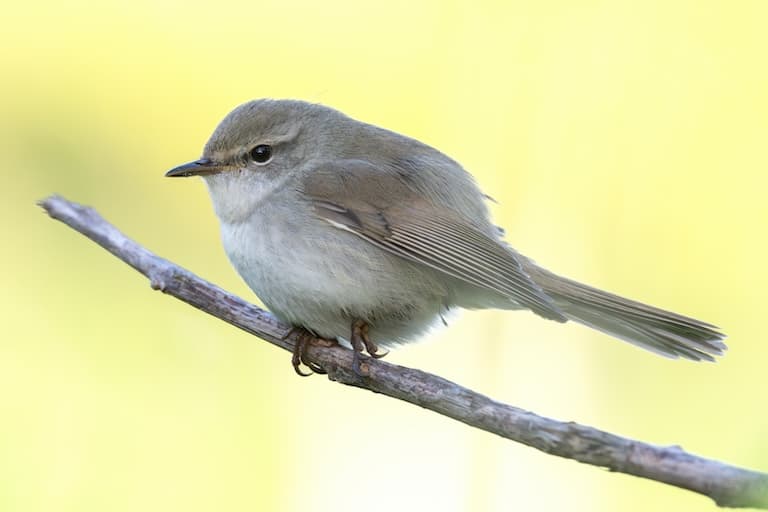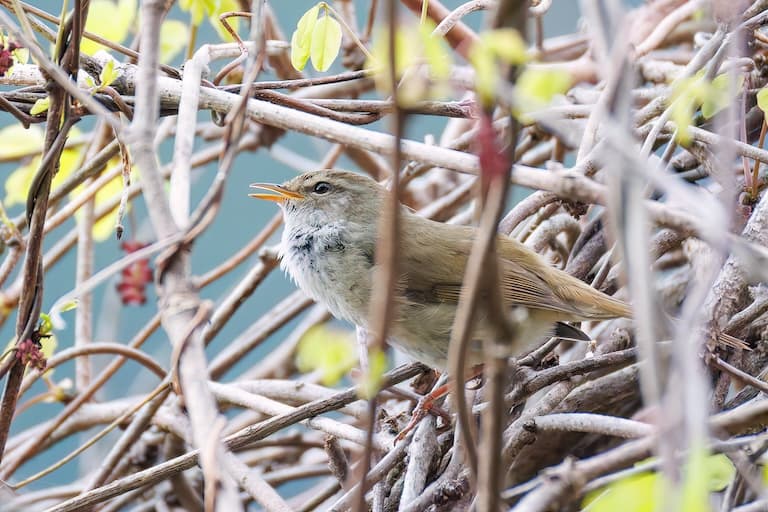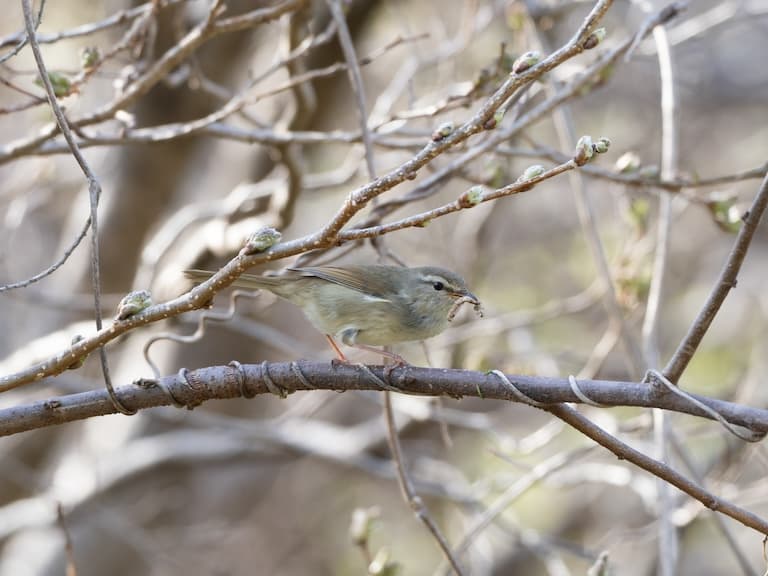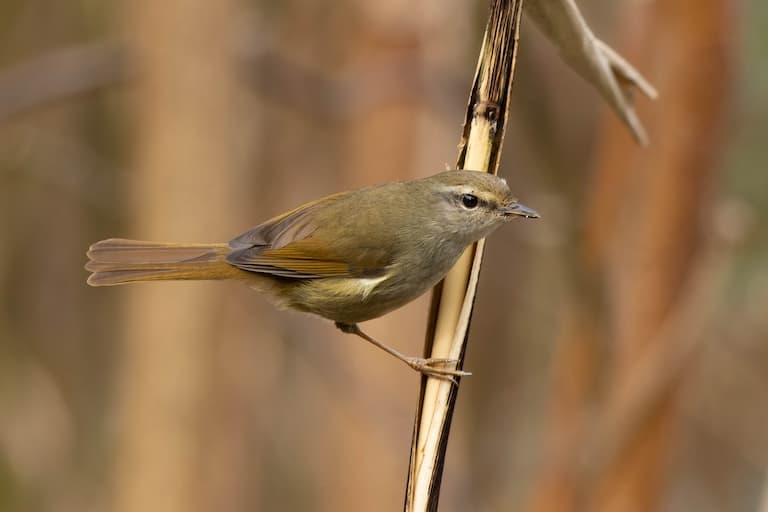Uguisu Profile
For all its wonderful food, culture and landscapes, Japan is perhaps most notorious for its fascinating social quirks. One of these, as we’re about to discuss, involves the addition of bird guano to the faces of beautiful women. So, when the phrase “Japanese Bush Warbler” is heard for the first time, you could be forgiven for thinking it was something more sinister than a sweet little songbird, whose local name comes from its call: Uguisu.

Uguisu Facts Overview
| Habitat: | Forest edges |
| Location: | Japan, Philippines, visitor to Taiwan, Korea, China |
| Lifespan: | Unknown |
| Size: | 15.5 centimetres (6.1 in) long |
| Weight: | Not recorded |
| Colour: | Olive brown on the back, lighter grey-brown underneath |
| Diet: | Insects |
| Predators: | Weasels |
| Top Speed: | Not recorded |
| No. of Species: | 1 |
| Conservation Status: | Least Concern |
The Uguiso, or Japanese bush warbler, is far more interesting than it looks. This tiny, plain-looking bird has a very pretty song, and one that’s inspired art, imprisonment and even bird poo facials across the range it inhabits. Despite being coveted for all this and more, the species itself appears to be doing fine.
The people who smear its faeces on their faces, though, we can’t be so sure.
Interesting Uguisu Facts
1. They’re warblers
Uguisu are known as Japanese bush warblers by most English-speaking birders, and warble they most surely do. They’re in one of the warbler families, Cetidae, but warblers as a whole aren’t a taxonomic group, and the common name can’t imply any relationship between them.
This family contains 8 genera, the most populated being Horornis, where we find this little fella, and it’s heard more than it’s seen – this small bird is well known for its call but is quite unassuming to look at, and hard to spot in the trees!

2. They’re musical
Alexander Lierbermann, a classical composer, has the song of this little bird recorded in sheet music for the violin. Among others, the Uguisu makes up a creative portfolio of animal calls expressed on classical instruments in his collection.
But contemporary composers are, of course, not the first to notice the unique song of this bird; it has an ancient history of reverence among those cultures that expanded around it.
Its call has inspired poetry for thousands of years in Japan, and its music is often associated with the spectacular Ume blossoms that turn Japanese parks pink with flowers as Winter subsides.
When the English finally found it, it was called the “Japanese Nightingale”, after Europe’s most romantic bird.
Unfortunately for the animal, the human hug of death is a common fate.
3. They’re caged
Asia is a big place with almost 50 countries and hundreds of languages, but one sweeping generalisation that we might be able to slip through is that almost everywhere you go, you can find small birds in small cages.
Many strains of Buddhism include the belief that if you pay for the freedom of one of these caged birds, you’ll be granted some hefty positive karma, and this commonly leads to the birds being caught and taken out of the wild to be put into cages for this purpose, as is the loopholed nature of religious dogma everywhere.
One popular bird unwillingly involved in practices like this is the Uguisu, whose call is supposed to herald the spring, and so it is kept in small boxes by the window.
This sort of practice highlights the very human juxtaposition between the admiration of an animal and the desire to keep it contained, and it’s a sad state of affairs for the animals we take for granted.
But at least the species as a whole is doing well, if not the individuals imprisoned on porches. The species was assessed as recently as 2024, and is listed as of Least Concern by the IUCN1.
4. Uguisu no fun
One Japanese cultural phenomenon inherited from Korea is the use of bird poo as a face mask.
Centuries before a “Western beauty standard” would take the blame for global skin whitening, cultures all over the world were doing it as a way to signify a lack of exposure to sunlight, which would have been a sign of wealth in times when most working-class jobs were outdoors.
In Japan, white paint is one of the defining characteristics of the Geisha, and this white paint was, for a long time, removed using the poo of this little bird, the Uguisu.
Uguisu no fun is the anglicised phrase that means “Nightingale shit” in Japanese, and this is used both inside Japan and more recently even in the Western world by people with nothing more interesting to do with their lives2.
This guano was probably originally used to remove stains from clothing, and this acidic nature is how it also bleaches the skin. Because, interestingly, the Uguisu has less uric acid in its poop than most birds, and produces more urea instead.
Urea, the pungent ingredient in urine, is water-soluble, and since birds fly, and removing urea removes water with it, birds tend to opt for the white chalky uric acid poops in order to save the little water they can carry.
But the uguisu presumably just drinks more than other birds to make up for it. And this allows it to poop however it wants. Between this fact and the usage of it as a white face mask, there’s certainly a scene or two missing, but here we are3.

5. They’re trapped for this purpose, too!
Sadly, the natural diet of the Uguisu isn’t quite perfect enough to make just the right kind of poo for smearing all over your face, so instead of wild birds, Japanese “nightingale farms” were set up to control the diet, keep the birds contained in cages and harvest their delicious droppings.
In classic Japanese fashion, this is a whole process that could be artfully accompanied by traditional Japanese music in an Artisanal YouTube video depicting it, but essentially, it’s scraped off the cages, sanitised with UV light, dried for weeks and sold as a ground-up powder for some wealthy person to put on their face4.

Uguisu Fact-File Summary
Scientific Classification
| Kingdom: | Chordata |
| Phylum: | Animalia |
| Class: | Aves |
| Order: | Passeriformes |
| Family: | Cattidae |
| Genus: | Horornis |
| Species Name: | diphone |
Fact Sources & References
- (2024), “Japanese Bush-warbler”, The IUCN Red List of Threatened Species in 2024.
- Moore (2001), “The Nightingale Facial”, The Wall Street Journal.
- Freeman, “Geisha Facials”, HowStuffWorks.
- Shinichi(2010), “The Facial that uses Nightingale Droppings”, IKEDA SPA.
